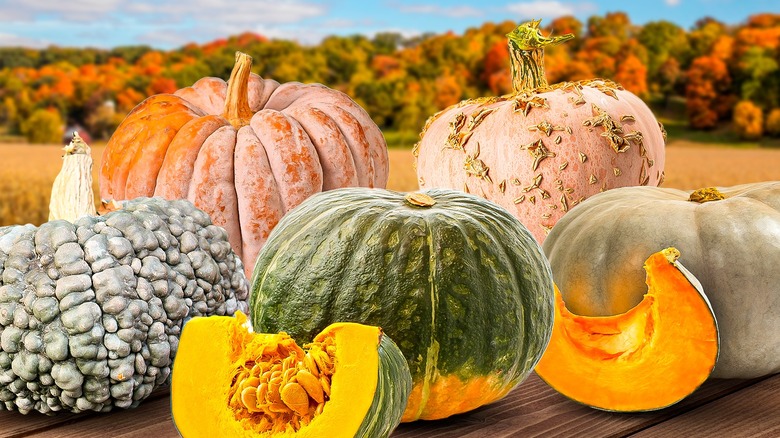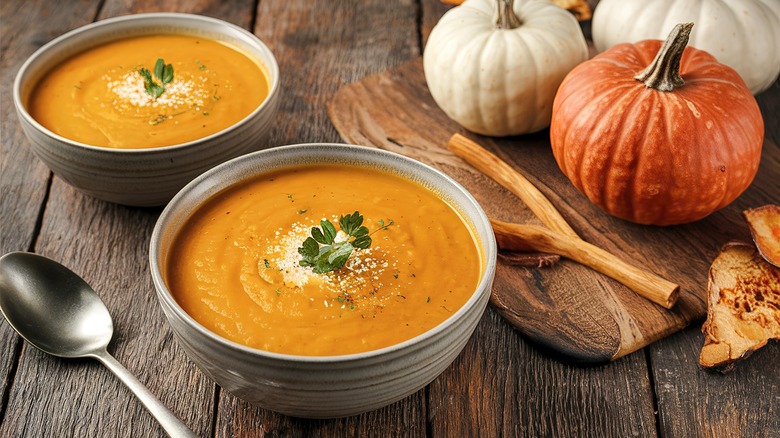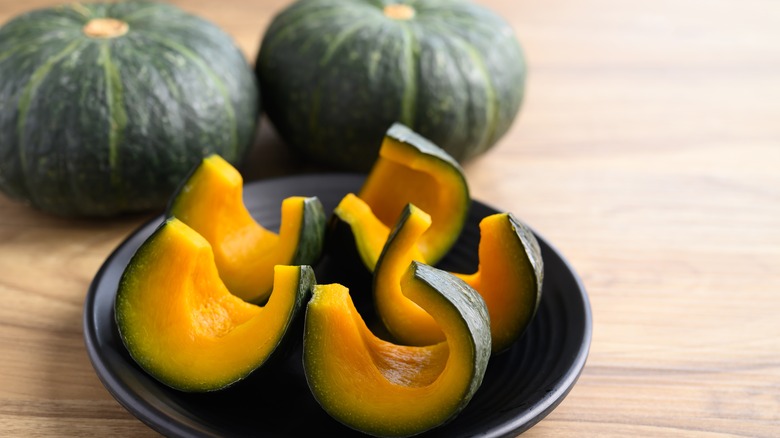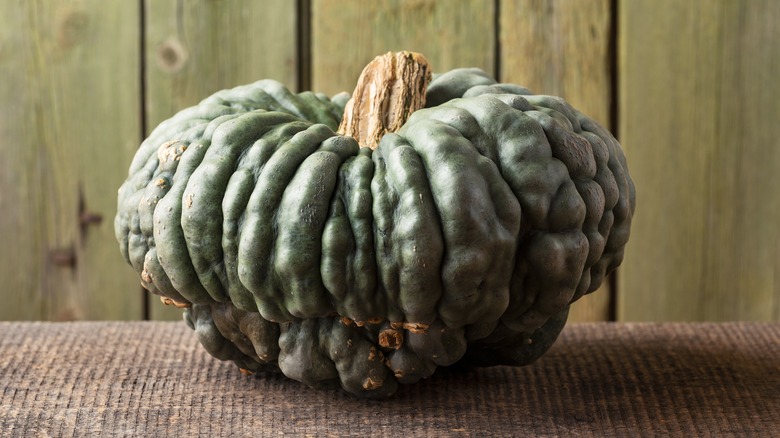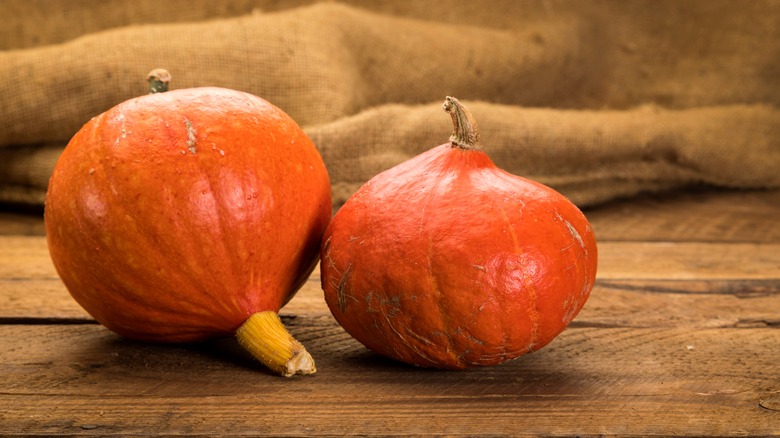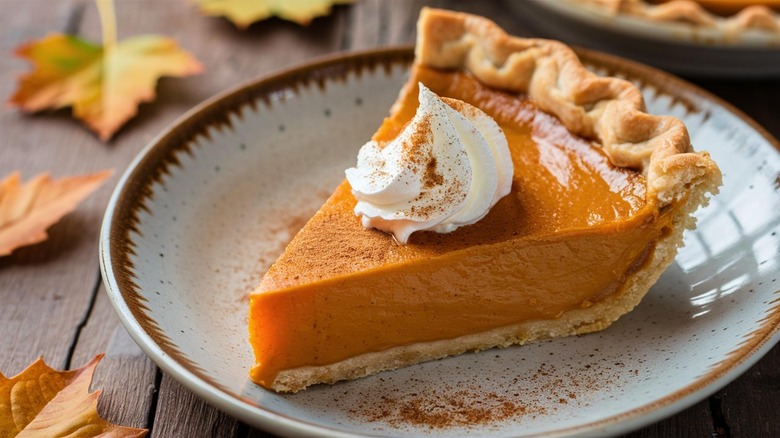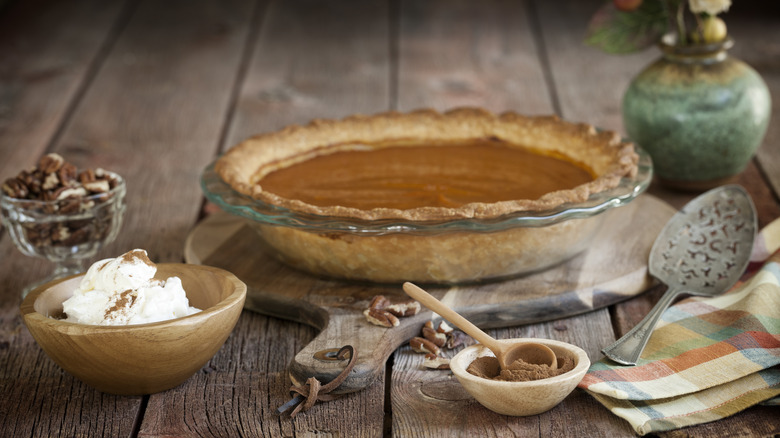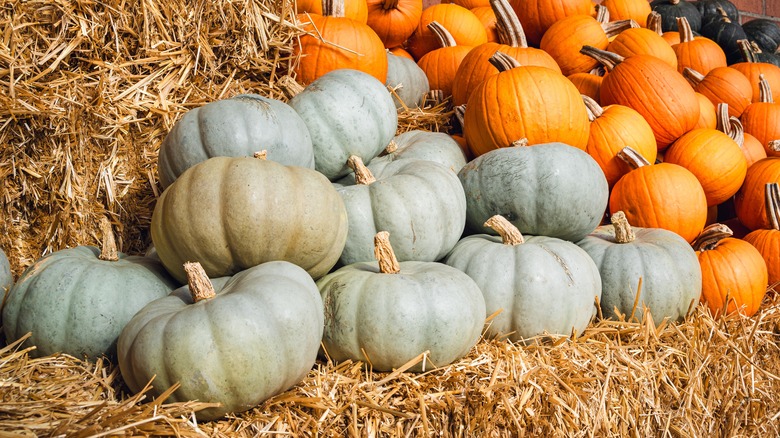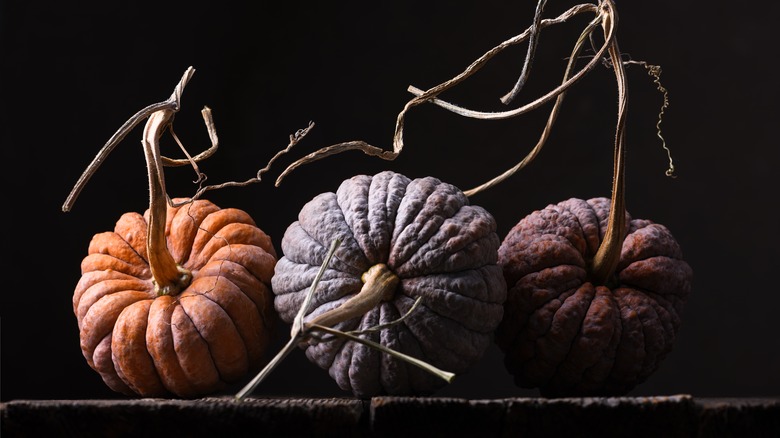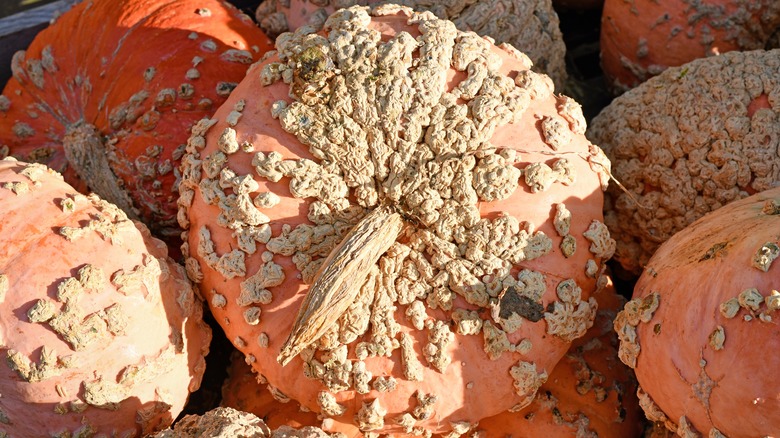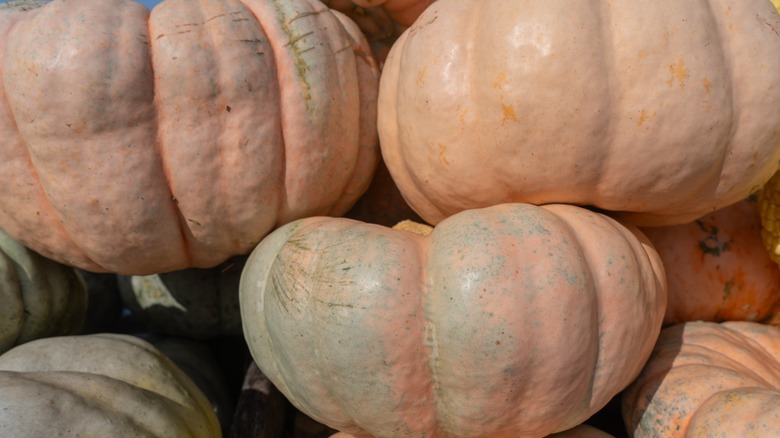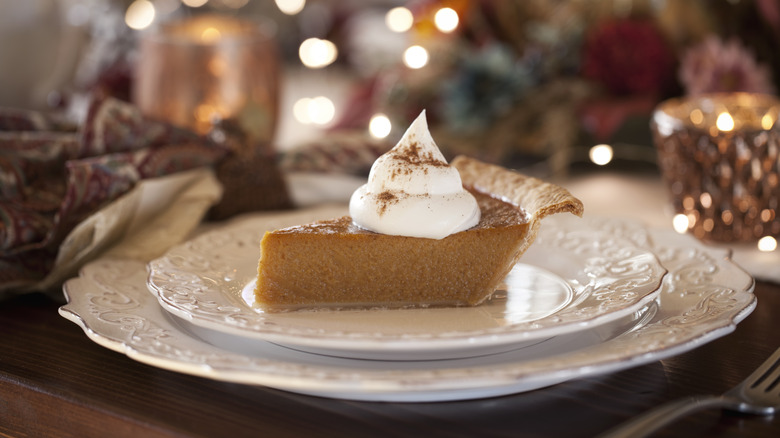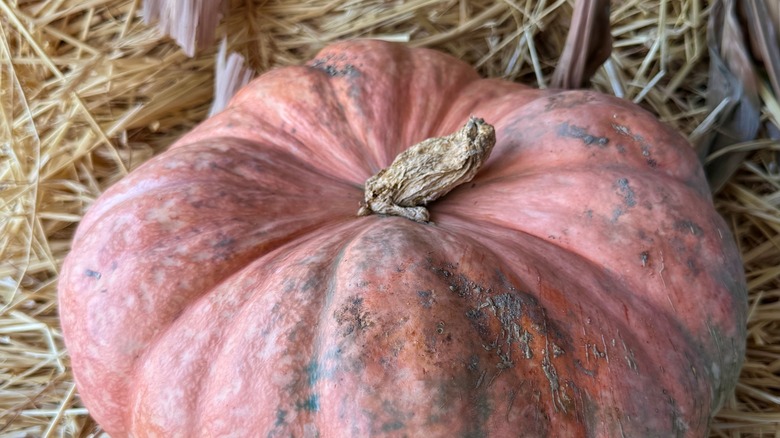12 Varieties Of Pumpkins You Should Try Cooking With
When pumpkin-spice everything starts to show up, so do actual pumpkins. Many of us are happy just to grab a big orange one (or two or three) for carving and a few cute little ones for seasonal decoration. The more intrepid among us, however, may toy with the idea of cutting them up and making pumpkin pie or tasty pumpkin cornbread from scratch — after all, pumpkins are all over the place in the fall, and it seems a waste to use them only for decoration.
But figuring out which ones to choose for cooking can be a puzzle. Pumpkins come in a range of shapes and sizes, from tiny and white to green to striped to the familiar large orange ones — are they all even edible? While none of them will kill you if you eat them, some are better for cooking than others. And on top of that, they differ enough in flavor and texture that some may work better in certain dishes than others. To help you choose the right pumpkin for whatever treat you have planned, we've asked certified master gardener Mary Jane Duford and chef Hunter Evans of Mayflower Café in Jackson, Mississippi, for their best tips.
Sugar Pie
When many of us hear the word pumpkin, the first thought that comes to mind is pie. So if you're trying to think of something creative to do with a whole, fresh pumpkin, it's natural to think of turning it into pie filling. Sure, canned pumpkin purée makes pumpkin pies a snap to put together, but fresh pumpkins could offer an extra dose of flavor — not to mention serious bragging rights.
And if you happen upon a pile of smallish round pumpkins labelled Sugar Pie pumpkins, you may think you've found the makings of a perfect pie — with a name like that, how can they not make a fantastic pie filling? But as Mary Jane Duford warns, names can be deceiving. "Despite the name, it's better for soups than pies due to watery texture," she says. And in case you were wondering, yes, pumpkins are just as good in savory dishes as in desserts. If you're looking for a good use for a sugar pie pumpkin, for example, try this Thai-inspired coconut pumpkin soup.
Kabocha
If you've heard of Kabocha, you may have heard it referred to as a squash, and this would be correct: No clear technical difference distinguishes squashes from pumpkins, although the term pumpkin is typically used for types of squash with hard rinds. Originally from Cambodia and introduced to Japan, where they got their name, Kabocha squashes have a typical pumpkin shape (round, ribbed, and slightly flattened), but boast dark green skin with pale stripes. However, their flesh is deep orange, like that of a prototypical pumpkin.
And they also make great eating pumpkins, especially in savory dishes, as Mary Jane Duford notes. When cooked, she said, they have a "dry texture, similar to mashed potatoes, with a slightly sweet flavor. [They're] delicious in soups, hearty stews, or mashed as a side." Because Kabocha is dense and firm when cooked, it lends itself to a range of other preparations. In Japan, for instance, a favorite treatment for Kabocha is to cut it into thin slices and fry it up as tempura.
Marina di Chioggia
The Marina di Chioggia pumpkin is not one you're likely to see in a jack-o'-lantern display. It boasts a warty green skin more reminiscent of a reptile than a typical fruit. But while unusual in the States, it's beloved in its Italy, where it was first introduced from its native South America in the 1600s. Italian cooks have devised a variety of dishes to take advantage of these pumpkins, and according to Mary Jane Duford, these are still great ways to enjoy their "creamy, dense flesh with a savory-sweet profile."
"[They're] perfect for gnocchi, ravioli filling, pasta sauces, or grilled slices topped with herbs," Duford says. A traditional, and very autumnal, topping for pumpkin pastas is sage brown butter sauce, which also has the benefit of being quick and easy to make — not a bad thing, since making filled ravioli from scratch, fun and rewarding as it may be, is a bit of a project.
Red Kuri
Another less-common pumpkin variety, Red Kuri is not always easy to find in stores in the U.S. But if you have a green thumb, you can easily obtain seeds to grow the pretty pumpkin, which is shaped like a wide teardrop with thin, glossy orange skin. First cultivated on Hokkaido Island in Japan (the reason for its alternate name, Hokkaido pumpkin), it is now grown and eaten in locales around the world including France and New Zealand.
Because Red Kuri pumpkins are relatively small (cantaloupe-sized) with thin skins and tender flesh, they're easy to work with. This makes them a good choice if you don't have the tools, muscle, or inclination to tackle a large, hard pumpkin. Their flavor, according to Mary Jane Duford, is "creamy and slightly nutty with a mild sweetness." This, she says, makes them great "puréed in soups, roasted in the oven with garlic, or incorporated into curries."
Dickinson
For many of us, pumpkin pie is the taste of Thanksgiving, and a can of puréed pumpkin is the taste of pumpkin pie. The dependable little cans not only enable us to make great pies every time, they're super-easy to work with — so why mess with perfection? Even intrepid cooks who gleefully make everything from long-smoked brisket to puff pastry from scratch may forgo the adventure of truly homemade pumpkin pie, fearing the flavor simply won't be the same.
If you're among those who are torn between their love for culinary challenges and love for tradition, you can honor both by seeking out a Dickinson pumpkin. This varietal features large (10-pounds and over) fruit with smooth, pale beige skins and dense, dry, and sweet flesh. First cultivated in Kentucky in the early 19th century, Dickinson pumpkins are now the main varietal used in canned pumpkin production. While Libby's now uses its own proprietary variant of the Dickinson pumpkin for its beloved canned purée, Mary Jane Duford recommends that you find or grow your own Dickinsons if you crave a pumpkin pie with that "classic" flavor.
Quaker Pie
The very name Quaker Pie pumpkin evokes homespun coziness. Say it and the image of a rustic homemade pie cooling on a windowsill comes to mind — and chances are, your mental image will also include a handmade quilt and a beloved elder knitting in a rocking chair or rolling out dough for another pie.
Your mental image wouldn't be wrong. This heirloom varietal did indeed originate on a Quaker homestead, where it was intended for cooking and eating, rather than for decoration. Quaker Pie pumpkin plants yield smallish fruit with cream-colored skin and firm, pale interiors. While they lack the vibrant orange flesh of more familiar pumpkin varieties, their flavor is anything but dull — smooth and reminiscent of coconut, according to Mary Jane Duford. In addition, their dense texture and lack of stringiness has made them a longtime favorite for pie filling. So if you're curious to sample a taste of the past, a pie made from Quaker Pie pumpkin may be just what you need.
Jarrahdale
Jarrahdale pumpkins are as attractive to look at as they are to cook and eat. Originally cultivated in Australia, they're big and dramatic-looking, with a slightly flattened shape, deep ribs, and an elegant, pale blue-green skin that makes them a stylish addition to a contemporary tablescape.
But they also make great eating pumpkins. Cut through the bluish skin and you'll be greeted by intense orange flesh with a dense texture and a hint of sweetness. Australian cooks love to roast slices of this dramatic pumpkin as a savory side dish, and Mary Jane Duford also recommends Jarrahdales for a range of other savory dishes. "[They're] nice in savory stews, grilled pumpkin steaks, roasted chunks in grain salads, or a creamy pumpkin risotto," she says. The only catch, Duford warns, is that the Jarrahdale's thick rind and dense flesh can be challenging to cut through — so if you plan to cook one, be sure to have a sharp, heavy knife at the ready and prepare for a bit of a workout.
Black Futsu
Depending on your sense of style, the Black Futsu, a pumpkin cultivar from Japan, may be either the prettiest or ugliest pumpkin you've ever encountered. It's certainly distinctive: It's deeply ribbed with bumpy, warty skin that can range from green to tan, depending on the age of the fruit. Its vaguely reptilian look gives the impression of toughness. But in reality, the skin is thin and edible, and the orange flesh inside is delicate and flavorful.
Mary Jane Duford recommends using its "sweet, nutty flesh with hazelnut notes" for savory dishes. "[It's] perfect roasted with herbs, stuffed with wild rice or grains, or used in tempura," she says. If you need inspiration, try using Black Futsu in our wild rice and walnut-stuffed squash recipe for a showstopping meatless main course for your next autumn dinner party — or for any vegetarians at your Thanksgiving dinner. Even your omnivore friends and family may enjoy it more than turkey.
Galeux d'Eysines
The Galeux d'Eysines, a relatively uncommon French heirloom varietal, is another proud member of the warty squash club. Indeed, other names for it include the Warted Sugar Marrow, the Uncle Fester Pumpkin, and the Peanut Pumpkin, and these names are apt — the distinctive warts, which resemble peanuts in the shell, are so ugly they're pretty, which is why this variety, when you can find it, is often sold as a decorative gourd.
But if you find one and use it only for a Halloween or fall harvest display, you're missing out. The warts are actually caused by the sugars that develop in the pumpkin's flesh, so the more warts on the pumpkin, the sweeter its taste. And this "sweet, dense flesh," according to Mary Jane Duford, makes the Galeux d'Eysines another great option for a pie filling. It's also great in soups, where its fruity sweetness and creamy texture play well with more savory seasonings. Like other densely textured and richly flavored pumpkins, however, it's a challenge to cut and work with — but if you're patient, the payoff will be well worth it.
Porcelain Doll
By now, you may have the impression that the strangest-looking pumpkins are often the tastiest, and you would be correct. "In general, unusual-looking pumpkins and heirloom cultivars are generally better for cooking than bright orange jack-o'-lantern-style pumpkins," Mary Jane Duford says. She explains that this is because the oddball varieties were bred for flavor, rather than looks. (And conversely, she warns that the big orange orbs used for carving are typically watery, bland, and stringy — in short, not the best choice for your next homemade pumpkin pie or gratin.)
But some fairly normal-looking pumpkins can be great in the kitchen. An example of this, Duford says, is the Porcelain Doll, a newer pumpkin variety that cooks up like an heirloom. It has a prototypical pumpkin shape – it's big, roundish, and evenly shaped –- but it's distinguished by its pale pinkish-beige skin. Duford shares that it's also a good all-purpose pumpkin for cooking. "It's delicious for roasting, salads, or desserts," she says.
North Georgia Candy Roaster
While we have dozens of possible pumpkin types to choose from in principle, supermarkets typically carry only a few decorative types. This means you might have to do some legwork to find the more interesting varieties for cooking. "Less common varieties can be grown at home, purchased at the farmers market, found at roadside farmstands, and increasingly ordered from specialty retailers and boutique floral shops," Mary Jane Duford explains.
What most of Duford's recommended sources have in common is they feature locally grown pumpkins. They're not only fresher, more convenient, and more affordable than specialty pumpkins shipped across the country, they allow you to experience regional cuisine in its purest form. This is also why Hunter Evans looks for pumpkins grown just down the road from his Jackson, Mississippi restaurants. "My all-time favorite pie is made from scratch using North Georgia Candy Roaster Heirloom pumpkins, grown locally by Two Dog Farms in Flora, Mississippi," he says. "This recipe might just make its debut on the Mayflower Café menu this fall."
Fairytale
A French varietal, the Fairytale pumpkin (also known as Musquée de Provence) is a French heirloom variety. One can easily imagine this being the pumpkin the storytellers who created Cinderella had in mind — it's so huge (typically 20 pounds or more) that one can easily imagine it as a round little coach. And because it's so big, Mary Jane Duford says that European markets often sell it in slices for cooking.
Because you're likely to obtain this variety in large quantities, it's a good thing it's uniquely versatile. Its "deep flavor and smooth texture," Duford says, make an especially rich and creamy pie filling. But it's just as good in savory dishes, where its dense flesh holds its shape well. "Use it in ratatouille, pumpkin risotto, or sliced and grilled," Duford suggests. In addition, you can swap it in for any other winter squash variety in dishes such as soups or even tempura.
